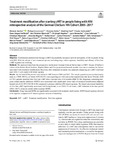2020-07-01Zeitschriftenartikel
Treatment modification after starting cART in people living with HIV: retrospective analysis of the German ClinSurv HIV Cohort 2005–2017
Stecher, Melanie
Schommers, Philipp
Kollan, Christian
Stoll, Matthias
Kuhlendahl, Frieder
Stellbrink, Hans-Jürgen
Wasmuth, Jan-Christian
Stephan, Christoph
Hamacher, Laura
Lehmann, Clara
Boesecke, Christoph
Bogner, Johannes
Esser, Stefan
Fritzsche, Carlos
Haberl, Annette
Schürmann, Dirk
Degen, Olaf
Horst, Heinz-August
Hoffmann, Christian
Jensen, Björn
Schwarze-Zander, Carolynne
Platten, Martin
Fätkenheuer, Gerd
Schmidt, Daniel
Gunsenheimer-Bartmeyer, Barbara
Vehreschild, Jörg Janne
Objective
Combination antiretroviral therapy (cART) has markedly increased survival and quality of life in people living with HIV. With the advent of new treatment options, including single-tablet regimens, durability and efficacy of first-line cART regimens are evolving.
Methods
We analyzed data from the prospective multicenter German Clinical Surveillance of HIV Disease (ClinSurv) cohort of the Robert-Koch Institute. Kaplan–Meier and Cox proportional hazards models were run to examine the factors associated with treatment modification. Recovery after treatment initiation was analyzed comparing pre-cART viral load and CD4+ T-cell counts with follow-up data.
Results
We included 8788 patients who initiated cART between 2005 and 2017. The sample population was predominantly male (n = 7040; 80.1%), of whom 4470 (63.5%) were reporting sex with men as the transmission risk factor. Overall, 4210 (47.9%) patients modified their first-line cART after a median time of 63 months (IQR 59–66). Regimens containing integrase strand transfer inhibitors (INSTI) were associated with significantly lower rates of treatment modification (adjusted hazard ratio 0.44; 95% CI 0.39–0.50) compared to protease inhibitor (PI)-based regimens. We found a decreased durability of first-line cART significantly associated with being female, a low CD4+ T-cell count, cART initiation in the later period (2011–2017), being on a multi-tablet regimen (MTR).
Conclusions
Drug class and MTRs are significantly associated with treatment modification. INSTI-based regimens showed to be superior compared to PI-based regimens in terms of durability.

